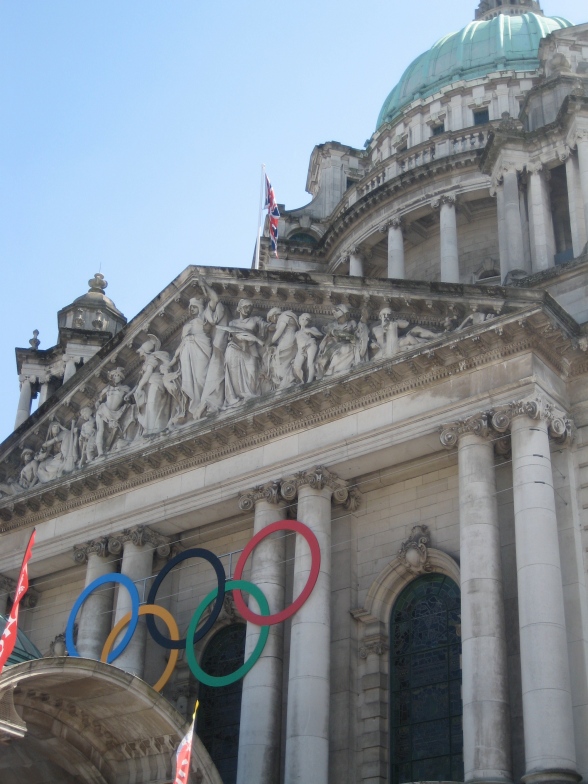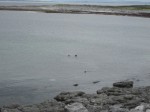A highlight of my semester that I don’t want to miss describing is my amazing trip to Sligo this past weekend. My friend Emma from my English class lives there, and she invited me to stay.
Sligo is a town of about 20,000 in Sligo County, Connacht, Republic of Ireland. Connacht refers to the four historical provinces of Ireland: Ulster, Munster, Leinster and Connacht. Ulster includes the counties of Northern Ireland as well as three in the Republic. Connacht encompasses much of the rocky and wild west coast, including Sligo and Galway, where I’ve been traveling.
I loved Sligo, and here’s why. The varied landscape is stunning and provides many opportunities for outdoor recreation. Sligo looks much like the part of Vermont where I’ll be working at summer camp when I return to America, but with a beach as well as beautiful mountains, rivers and lakes. Emma, her mum and I canoed on the river (I believe the Garavogue), docked, climbed out and visited the Holy Well across the road, a secret holy well in the forest which has pagan significance as a fertility site as well as Catholic significance. It was used as a secret spot for mass in penal times, when England controlled the religious, educational and property rights of Catholics in Ireland. Mass services still take place at the Holy Well today; for example, one of Emma’s cousins was baptised there! We had tea on the dock with a swan who was a little too interested in our biscuits (or “biccies” as my hosts would say) and canoed back.
Another element of Sligo I loved was that it’s steeped in history, like much of Ireland. At Drumcliffe Cemetary, I visited the grave of Yeats, who loved Sligo so much he wrote tons of poems there and lived there much of the time, though he wasn’t from there. There is also the largest megalithic cemetery in Ireland, the Carrowmore tombs. Emma’s mum, a recently retired university lecturer in art and design, actually helped excavate one of these tombs back in the day! The tombs include dolmens in the style of those like Poulnabrone and the Giant’s Ring, as well as more elaborate passage tombs like that at Newgrange. We also climbed Mt. Knocknarea to see the cairn that probably contains the remains of the legendary Queen Maeve (Mebhdh if you’ve brushed up on your Gaelic). Mebhdh was a feisty, fierce and determined warrior queen. In other words, like many heroines from Irish folklore, she coulda been a Scottie.
Finally, I had fun in Sligo because Emma’s upbringing in Sligo reminded me in certain ways of my upbringing in Union. Emma’s mum eats porridge for breakfast every morning, just as my mum eats oatmeal every day. Emma and her mum were also pleased that I prefer brown bread and rice over white, red wine over white. “You’ll fit in well here!” Emma kept saying. They took great care of me as a vegetarian; we ate delicious vegetarian food all weekend, including fresh veggies from their little back garden. We also consumed large quantities of tea, naturally. Because Sligo is a small town, whenever we went to the pub and such, Emma and her mum saw people they knew. Emma caught up with several people she knew from school when we were out, something I inevitably find myself doing when I go to, say, La Fogata or Wal-Mart in Union.
I made so many fun comparisons! Queen’s is about a three and a half hours drive from Sligo, comparable to the distance from Union to Agnes Scott. Finally, at one point when we overheard a very colloquial conversation on the street, Emma giggled and said, “That’s a Sligo accent. People are like, you’re from Sligo? Yeah, I don’t have a Sligo accent.” This is what people often say about me and South Carolina as well!
So, Emma and I have some interesting background and experiences in common, even from different sides of the Atlantic. If only I had Emma’s lovely red hair as well;)
I am finished packing! In just about an hour and a half, family friends Ciaran and Loretta will pick me up and take me to their house in Antrim, close to the airport where I’ll catch my first flight towards home in the morning!




 No, I’m not going home yet. I just went to the Ulster-American Folk Park today, an outdoor, interactive museum in Omagh that explores immigration from the Northern Irish region to America.
No, I’m not going home yet. I just went to the Ulster-American Folk Park today, an outdoor, interactive museum in Omagh that explores immigration from the Northern Irish region to America.























